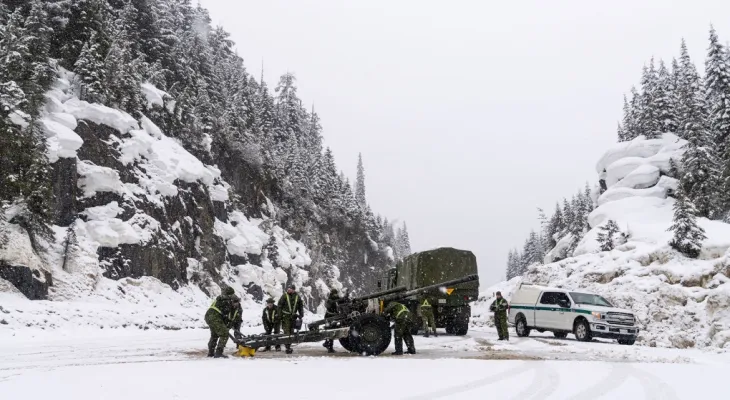Search here
Newspaper
Search here

Arab Canada News
News

Published: February 17, 2024
Thousands of people travel through Rogers Pass in Glacier National Park every day and they are likely unaware of the dangers surrounding them.
This is because they are driving their cars through the busiest avalanche corridor in North America.
Ross Campbell, the avalanche officer at Parks Canada stationed at Rogers Pass, said: "We have more than two million people driving through this section of the highway annually, and most of them are unaware of the avalanche danger above them."
Rogers Pass is located between Revelstoke and Golden, British Columbia, where the highway and the Pacific Canadian Railway wind through the Selkirk Mountains.
At an elevation of approximately 1300 meters above sea level, Rogers Pass receives an average of 10 meters of snowfall each winter, with more than 130 active avalanche paths intersecting a 40-kilometer stretch of busy highway.
Since 1961, a year before the full opening of the Trans-Canada Highway, Parks Canada and the Canadian Armed Forces have worked together to manage the world's largest mobile artillery snow avalanche control program and the longest continuous domestic military operation in Canada.
The Palache operation sees artillery forces from the regular and reserve forces stationed at Rogers Pass from November to April.
Members use 105mm howitzer guns and fire high-explosive shells from 17 locations along the pass to trigger avalanches in a controlled manner before they become a threat to the highway and railway line.
The gunners detonate unstable snow blocks from 270 designated targets, at distances up to 5000 meters.
Lieutenant Joel Mensah, the force commander, said: "Charge 7 is the highest charge we can fire from this weapon and allows for the greatest impact. So, we can send vibrations into the snowpack and then cause avalanches in the concerning areas." for the Palache operation.
"I feel greatly rewarded to be here and help with these very critical details that most people don't realize are necessary.
In a slow season, the gunners fire between 300 and 500 shells to cause avalanches, and this number rises to 1000 shots in a busy season.
The forces work with Parks Canada, which is continuously assessing avalanche hazards, monitoring them, and determining where and when to conduct firing operations.
Other structures help deflect avalanches and slow their approach to the highway, such as avalanche barriers, snow sheds, and snow fences.
The cost of highway closures is 3 million dollars per hour at Rogers Pass
There is enormous pressure to keep Rogers Pass open with 4000 vehicles, up to 40 trains, and 77 million dollars’ worth of smooth travel through the transportation corridor daily in winter.
Parks Canada estimates the cost of highway closures at 3 million dollars per hour.
Campbell said: "This program is critical to keep people moving from west to east in Canada."
"We want to maintain people's safety and the economy's flow. It is a really critically important route across Canada and there are no easily available alternate routes."
Parks Canada closes the road to traffic before each firing session, and it takes between two and eight hours to completely remove fallen snow and debris before reopening it to traffic again. In total, this is nearly 100 hours annually in controlled closures.
"The real challenge we face is the increasing traffic volume, it keeps increasing more and more, so the places where we can keep traffic safely away from the icy terrain is one of the real challenges."
20 cm below standard snowfall level
About 2000 avalanches are recorded along the pass every year, with about 120 of those avalanches affecting the Trans-Canada, however, low snowfall has led to a slower season in 2024.
Campbell says that a La Niña winter caused a decrease in snowfall, and as a result, the number of slides in Rogers Pass decreased between November and early February.
He added, "Our snowfall has been 50 percent less than average, and we are about 20 cm below the all-time snowfall record at Fidelity Mountain in Rogers Pass."
"On average, we conduct 12 medium monitoring missions in winter, and this year we have done only three missions so far, so there has been less avalanche risk on the transportation pass this year."
This follows last year's deadly avalanche season.
During last year’s avalanche season, there were 15 fatalities, 14 of them in British Columbia. And one in Alberta.
Among these, five people died in three different slides near Glacier National Park.
According to Avalanche Canada, the season exceeds the national adjusted average of 11 avalanche deaths annually.
The deadliest avalanche in Canada occurred along Rogers Pass in 1910, when 58 railway workers were killed while clearing tracks after a previous snow slide.
As a result, CP tunnels were dug under Rogers Pass and the eight-kilometer Connaught Tunnel under Mount Macdonald was completed in 1916.
Comments